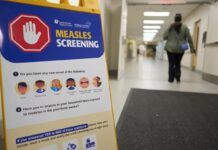The United States is nearing a critical juncture in its fight against measles, with the possibility of losing its “elimination status” – a designation from the World Health Organization (WHO) signifying sustained control of the highly contagious virus. This comes as Canada recently lost the same status, and outbreaks continue to spread across the Americas, raising serious concerns about a resurgence of a disease once considered largely eradicated.
The Stakes of Elimination Status
Achieving measles elimination is a major public health victory. It means the virus isn’t circulating freely within a country, protecting vulnerable populations – like infants too young to be vaccinated – who rely on herd immunity. Losing this status isn’t merely symbolic; it signifies a weakening of public health infrastructure and increasing risk for outbreaks. The Americas as a whole achieved elimination in 2016, but setbacks in Venezuela and Brazil demonstrate how quickly progress can unravel.
U.S. on the Brink
The U.S. has until January 2026 to regain control, following an outbreak that began in West Texas. As of 2025, over 1,753 measles cases have been recorded across 42 states, with three confirmed deaths. Alarmingly, over 90% of these cases occurred in unvaccinated individuals. This underscores the direct link between declining vaccination rates and rising infection numbers.
Experts warn that a reversal of elimination status would be a significant failure. “To seemingly turn back the clock… is very disheartening,” says William Schaffner, an infectious diseases physician at Vanderbilt University.
Why Measles Remains a Threat
Measles is exceptionally contagious. Maintaining elimination requires roughly 95% community immunity – either through vaccination or prior infection. However, barriers to vaccination persist, including geographical access, language/cultural concerns, and vaccine hesitancy.
The consequences of infection are severe: 1 in 5 unvaccinated individuals require hospitalization, with risks including pneumonia, vision loss, and even long-term neurological damage. The West Texas outbreak alone resulted in over 700 cases and two child fatalities.
The Path Forward
Experts agree that vaccination remains the most effective strategy. Addressing barriers to access and building trust within communities are crucial. Daniel Salas, an epidemiologist at the Pan American Health Organization, emphasizes the need for “a joint front” led by community leaders working with health officials.
The risk isn’t limited to the U.S.; as long as measles persists elsewhere, even eliminated countries remain vulnerable to imported cases and outbreaks. Global measles cases attributed to the Americas have risen from 0.1% in 2024 to over 7% in 2025, signaling a growing threat.
The looming loss of elimination status serves as a stark reminder: public health achievements require continuous vigilance and investment. Failing to protect against measles is not just a public health failure, but a preventable tragedy.








































